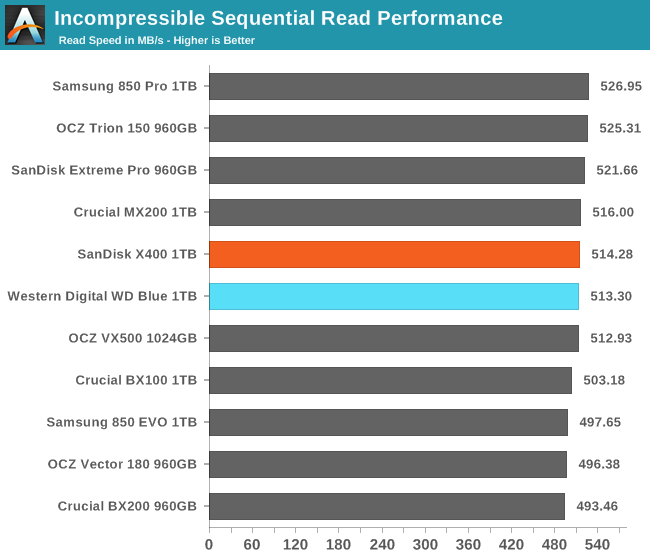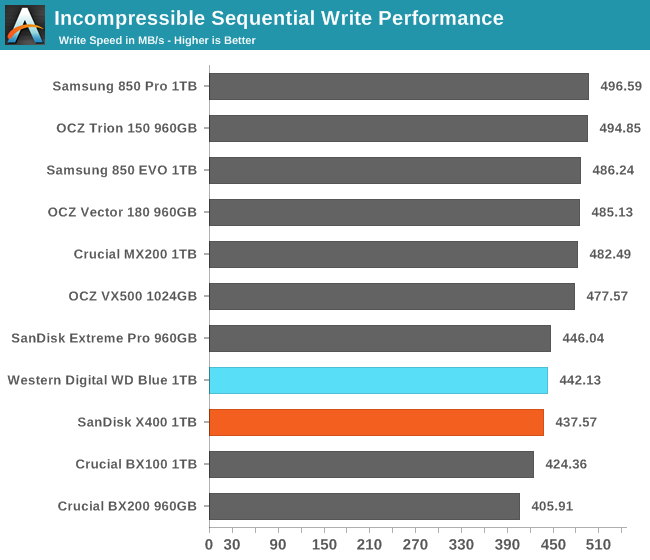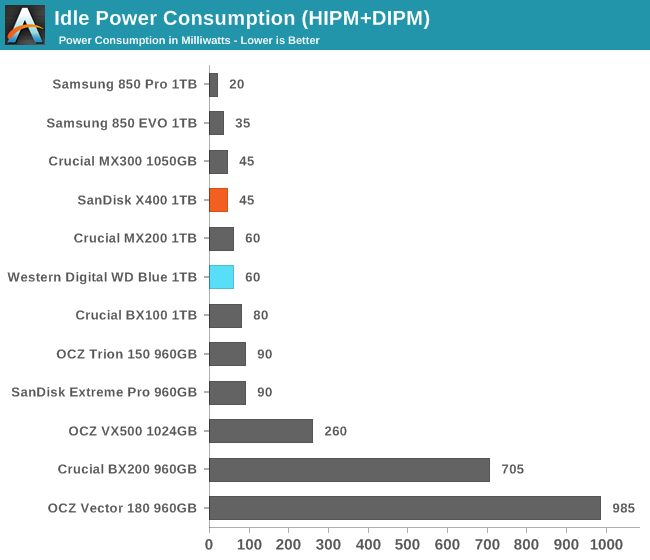The Western Digital Blue (1TB) SSD Review: WD Returns to SSDs
by Billy Tallis on October 11, 2016 8:00 AM EST- Posted in
- SSDs
- Storage
- Western Digital
- SanDisk
ATTO
ATTO's Disk Benchmark is a quick and easy freeware tool to measure drive performance across various transfer sizes.
 |
|||||||||
The WD Blue shows slightly better write speeds on the ATTO test than the SanDisk X400, but both fade a bit in read speed toward the end of the test.
AS-SSD
AS-SSD is another quick and free benchmark tool. It uses incompressible data for all of its tests, making it an easy way to keep an eye on which drives are relying on transparent data compression. The short duration of the test makes it a decent indicator of peak drive performance.


The AS-SSD test seldom shows large differences in performance, and the WD Blue performs almost identically to the X400. The write speed is still a bit on the low side.
Idle Power Consumption
Since the ATSB tests based on real-world usage cut idle times short to 25ms, their power consumption scores paint an inaccurate picture of the relative suitability of drives for mobile use. During real-world client use, a solid state drive will spend far more time idle than actively processing commands. Our testbed doesn't support the deepest DevSlp power saving mode that SATA drives can implement, but we can measure the power usage in the intermediate slumber state where both the host and device ends of the SATA link enter a low-power state and the drive is free to engage its internal power savings measures.
We also report the drive's idle power consumption while the SATA link is active and not in any power saving state. Drives are required to be able to wake from the slumber state in under 10 milliseconds, but that still leaves plenty of room for them to add latency to a burst of I/O. Because of this, many desktops default to either not using SATA Aggressive Link Power Management (ALPM) at all or to only enable it partially without making use of the device-initiated power management (DIPM) capability. Additionally, SATA Hot-Swap is incompatible with the use of DIPM, so our SSD testbed usually has DIPM turned off during performance testing.


The WD Blue uses a few milliwatts more at idle than the X400. In the slumber state this is not a problem and the WD Blue's power draw is about average. The active idle power draw is a bit on the high side given that the MX300 draws about two thirds what the WD Blue draws when both drives use the same controller and DRAM.










75 Comments
View All Comments
Decoherent - Friday, October 14, 2016 - link
There aren't a lot of reasons to use vendor-specific software (which often sucks) when you can use Macrium Reflect's free version, which is much more powerful. It's helped me sort out some other weird problems, too, such as fixing wrong UEFI entries that I couldn't figure out.jwcalla - Tuesday, October 11, 2016 - link
I don't think I would trust WD anything when it comes to storage.BrokenCrayons - Tuesday, October 11, 2016 - link
Why not? This is just a SanDisk drive with a few minor firmware tweaks. Besides that, WD was the industry leader before SSDs were a thing. Sure picking between Seagate, Quantum, Maxtor (omg that 4.3GB Bigfoot drive...how I missed your 3 months of dog slow performance before you started making the click o' death), and WD (I guess Toshiba and Hitachi too) was like picking between which rusty razor you'd prefer to slit your wrist with, but at least with WD drives you clould get a good gusher going before the blade broke.LordConrad - Tuesday, October 11, 2016 - link
I loved the Quantum Bigfoot, it was as great way to increase capacity for storage drives without having to wait for aerial density to increase.BrokenCrayons - Tuesday, October 11, 2016 - link
Oh the idea was sound. Going back to a 5.25 inch chassis to increase capacity seemed like a decent idea even though we'd long ago shifted to 3.5 inch drives. The problem with the Bigfoot was reliability. I had one I personally owned die on me and quite a few we sold to customers (12GB models) came back dead within less than 6 months. I remember all the hassles of getting RMAs done for those things. On the other hand, Quantum's 3.5 inch drives seemed fairly reliable. I wonder if there was a problem with heat expansion doing bad things to the read/write heads due to the larger platter size. It wasn't a problem with older 5.25 inch hard drives because they were usually full height and ran at a lower RPM than the Bigfoots.LordConrad - Tuesday, October 11, 2016 - link
I don't even remember what speed they ran at. Was it the full 5400rpm, or something slower like 5200 or 4900?BrokenCrayons - Wednesday, October 12, 2016 - link
I don't remember all the specs and had to look them up. The originals and the CY series ran at 3600 RPM and the TX, and TS series brought it up to 4000. If I recall correctly, when the Bigfoot was still in retail channels, a lot of 3.5 inch drives were ticking along at 3600 to 4200 RPM. 5400 RPM drives came along later and I don't know if Bigfoots were even in production when they were being sold as high performance storage solutions (well, non-SCSI drives anyhow...spindle speeds for SCSI devices were quite a bit higher).This is half from memory and the rest was from a couple of quick web searches so take all that with a grain of salt or two. I could be a bit off as it's been a long time.
mikato - Tuesday, October 11, 2016 - link
"I don't think I would trust anything when it comes to storage."That's better. Have backups that work.
But anyway, why all the dumping on WD? I don't think it is warranted.
barleyguy - Tuesday, October 11, 2016 - link
There have been many periods in the past where WD had very high failure rates. Because of that, many of us that have been around awhile have been bit in the butt by WD and don't trust them anymore. In the late 90s and early 2000s for instance, WD's failure rate was so high they had a wait queue and callback system set up for RMAs.That said, I think for last few years WD has been very good, so maybe it is unwarranted in the short term.
In particular I really like the WD Blue. They aren't fast, but they seem to be a very reliable drive, and throwing them in a RAID array with an SSD boot disk results in a pretty solid system.
Gigaplex - Tuesday, October 11, 2016 - link
Their main competitor, Seagate, has also had very high failure rates. Mikato was correct, don't trust any of them. There's no need to dump on WD more than the others.